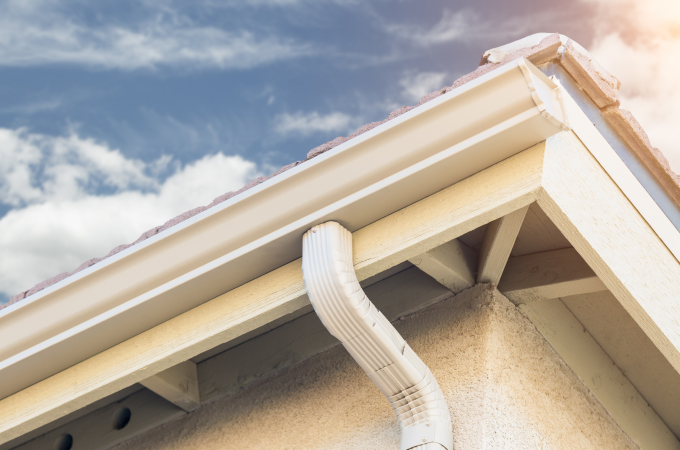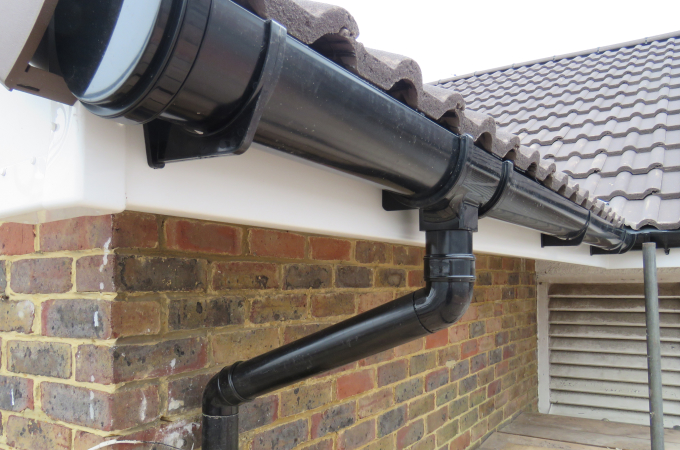PROPER GUTTER AND DOWNSPOUT SIZING DESIGN OF ROOF DRAINAGE SYSTEMS ROOF DRAINAGE
The roof is one of the most essential parts of a building as it protects occupants, contents, and interior of the structure from the elements. Once an architect has determined the kind of roof he intends to use, he must give equal attention to the design of the roof drainage system.
Factors to be considered in the design of roof drainage systems are the area to be drained, size of the gutter or gutters, downspouts, outlets, slope of roof, type of building, and appearance.
Roof Area to be Considered
The design capacity for a roof drainage system depends on the quantity of water to be handled. The quantity of water in turn depends on the roof area, slope, and rainfall intensity. In considering the roof area, it must be remembered that rain does not necessarily fall vertically and that maximum conditions exist only when rain falls perpendicular to a surface.
Since the roof area would increase as its pitch increases, then it would not be advisable to use the plan area of a pitched roof in the calculation of a drainage system. Experience has taught that use of the true area of a pitched roof often leads to oversizing of the rain gutters or gutter, downspouts, and drains.
Proper Gutter & Downspout Sizing
Rainfall intensity is usually given in inches per hour for a five minute duration or one hour duration based on U.S. Weather Bureau records. Based on records through 1978, gives five minute intensities for selected cities. New Orleans, Los Angeles, for example, may have 8 in./hr.(203mm/hr) for a five minute duration yet record only 4.8 in.(121 mm) in an hour over a 100 year period.� These rates correspond to 0.133 in./min.(3.4 mm/min.)and 0.08 in./min(2 mm/min.).
Local codes may require that drainage systems only be designed for the latter. It takes 96.15 square feet(8.93 square meters) of surface with 1 inch per hour(25 mm/hr) of water to correspond with 1 gpm (0.063 l/s) flow rate. Downspouts and rain gutters are sized in relation to rainfall on this basis.
Plumbing codes typically use the vertically projected roof area for drainage design and they often use a square foot allowance per square inch of downspout for 1 in./hr.(25 mm/hr) rainfall that varies with diameter, for example, 3 in.(76 mm): 911(85); 4 in.(102 mm):1100 (102); 5 in.(127 mm):1280 (119);6 in.(152 mm):1400 (130) and 8 in.(203 mm):1750 (163) sq. ft.(sq. m). Net drainage capacity.
Downspout Sizing
In sizing downspouts, the following considerations apply:
- Downspouts of less than 7.00 sq in.(4515 sq mm) cross section should not be used except for small areas such as porches and canopies.
- The size of the downspout should be constant throughout its length.
- Downspouts should be constructed with conductor heads every 40 ft(12.2 m) to admit air and prevent vacuum.
- Offset of more than 10 ft(3.0 m) can affect drainage capacity.
- The gutters outlet capacity should suit the downspout capacity.
- The downspout size must suit the bottom width of the rain gutter.
- Assuming that using the fewest number of downspouts is desirable, their locations will be affected by
- a. gutter capacity and length. To limit the effects of thermal expansion in gutters 50 ft(15.3 m) is a practical maximum length of gutter to be served by a downspout. Unless special provisions are made for flexibility in downspouts, rain gutters and their support systems, gutters should expand away from downspouts and downspouts should not be located near gutter expansion joints.
- b. the capacity of the inlet tube. A sharp bend at the inlet may clog.
- c. potential for water freezing in downspouts and rain gutters. Open, partially open or corrugated styles downspouts are suggested for areas subject to icing. Locating downspouts on the north side of buildings is not recommended for such areas.
- d. the appearance of the downspout system and a potential need for concealment. the greater capacity of a pitched gutters or gutter.
- f. the downspout discharge location. Water disposal at this location should be acceptable.
- g. the risk of rain gutter overflow from insufficient drainage capacity. h. a scupper serving a designated roof area.� After the number and location of downspouts have been determined, the areas to be drained by each downspout should be figured. In making this calculation for a pitched roof, the plan area should be adjusted according to recommendations given.
Sample Problem
Select downspouts for a building in Boston, Mass. The building is 100 x 85 ft.(30.5 x 26 m) with a double pitched roof having a slope of 6 in./ft.(152 mm/m).� The slope is toward the 100 ft.(30.5m) side. Maximum rainfall conditions will be used to determine downspout size.� It is decided to drain the building with 4 downspouts located at each corner of the building. An expansion joint will be installed in each gutter between the downspouts.
The plan area of this building is 8500 sq ft.(790 sq m).� Since the slope is 6 in./ft.(152 mm/m), factor 1.10 is used, making the design area 9350 sq ft.(868 sq m). Thus each of the four downspouts will serve a 2338 sq ft.(217 sq m) area. Opposite Boston, it is found that 1 sq in.(645 sq mm) of downspout will drain 170 sq ft.(16 sq m) of roof area. Divide 2338(217) by 170(16) to determine that each downspout should have a minimum area of 13.56 sq in.(8746 sq mm).� It is found that there is a choice of; a 5 in. (127 mm) Plain Round, a 5 in.(127 mm) Corrugated Round, a 5 in.(127 mm) Rectangular Corrugated, or 5 in.(127 mm) Plain Rectangular Downspout.
Gutter Sizing
In sizing gutters, the following considerations apply for typical section lengths of 8 to 10 feet( 2.41 to 3.0m):
Spacing and size of outlet openings. The gutter can never be any more effective than the outlet and downspout selected to drain it. Downspout sizes must not exceed the bottom width of the rain gutters.
Slope of the roof. The gutter must be of such a design and location that water from a steep pitched roof will not by its own velocity tend to overrun the front edge.
Style of gutters to be used. All gutters are not effective for their full depth and width.
Maximum length of gutter. 50 ft.(15.2 m) between ends or expansion joints is the limit unless the system is especially designed to accommodate the greater expansion, the larger flow and the need for special supports.
Rain Gutter support capability. (Supports should be based on full capacity of the gutter. Ice load capacity also affect the size and strength of the system.)
Sloped gutters may be. Formulae for flow in gutters with different pitch are not available. The capacity of a gutter with 1/16 in./ft.(5.21 mm/m) or less pitch is taken as that of a level gutter even though it is somewhat greater.
Rectangular Gutter Sizing
The size of rectangular gutters depends upon these factors:
- Area to be drained.
- Rainfall intensity per hour.
- Length of gutter in ft.(m)
- Ratio of depth to width of gutter.
Irregular Cross Section Gutter Sizing
The required sizes of gutters other than rectangular or round can be determined by finding the semicircle or rectangular area that most closely fits the irregular cross section.
Half Round Gutter Sizing
Half Round Gutter Sizing is based on W = 0.0182 (lA)2/5. W is the width in in.(mm). I denotes rainfall intensity, the roof area in square feet(sq m).
 Contractors
Contractors



